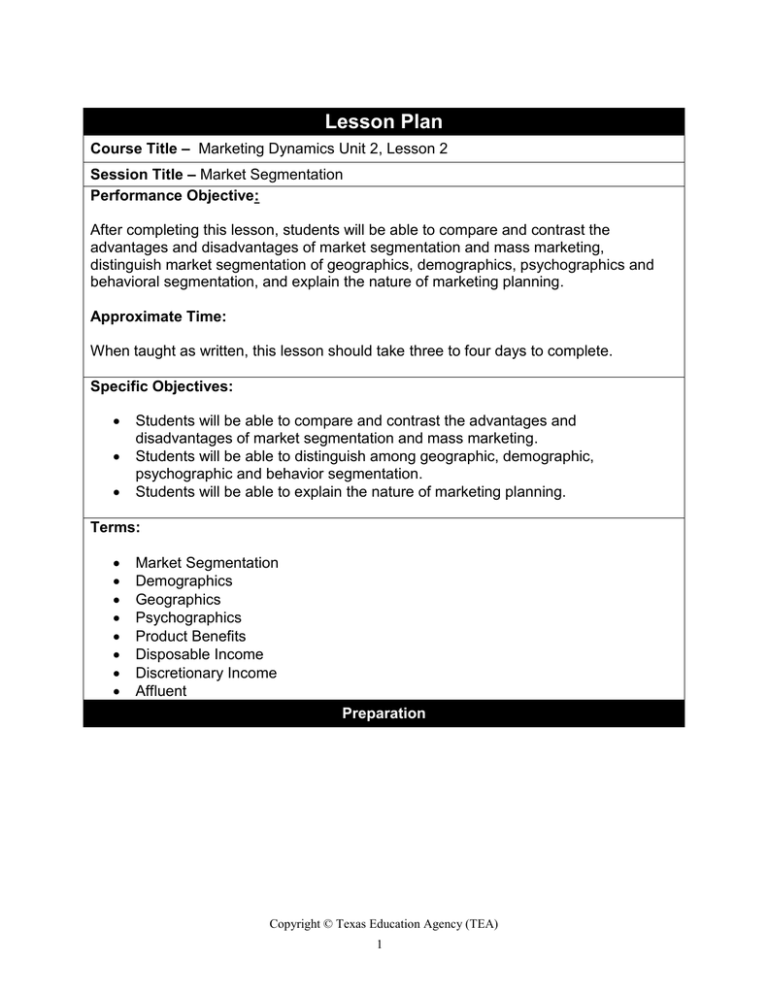Lesson Plan
advertisement

Lesson Plan Course Title – Marketing Dynamics Unit 2, Lesson 2 Session Title – Market Segmentation Performance Objective: After completing this lesson, students will be able to compare and contrast the advantages and disadvantages of market segmentation and mass marketing, distinguish market segmentation of geographics, demographics, psychographics and behavioral segmentation, and explain the nature of marketing planning. Approximate Time: When taught as written, this lesson should take three to four days to complete. Specific Objectives: Students will be able to compare and contrast the advantages and disadvantages of market segmentation and mass marketing. Students will be able to distinguish among geographic, demographic, psychographic and behavior segmentation. Students will be able to explain the nature of marketing planning. Terms: Market Segmentation Demographics Geographics Psychographics Product Benefits Disposable Income Discretionary Income Affluent Preparation Copyright © Texas Education Agency (TEA) 1 TEKS Correlations: This lesson, as published, correlates to the following TEKS. Any changes/alterations to the activities may result in the elimination of any or all of the TEKS listed. 130.347 (c)(5)(B) … compare and contrast the advantages and disadvantages of market segmentation and mass marketing … 130.347 (c)(5)(C) … distinguish among geographic, demographic, psychographic, and behavior segmentation … 130.347 (c)(5)(D) … explain the nature of marketing planning … Interdisciplinary Correlations: English: 110.31 (b)(21)(B) … organize information gathered from multiple sources to create a variety of graphics and forms (e.g., notes, learning logs)… 110.31 (b)(22)(B) …evaluate the relevance of information to the topic and determine the reliability, validity, and accuracy of sources (including Internet sources) by examining their authority and objectivity… 110.31 (b)(23)(C) … use graphics and illustrations to help explain concepts where appropriate… 110.31 (b)(23)(D) … use a variety of evaluative tools (e.g., self-made rubrics, peer reviews, teacher and expert evaluations) to examine the quality of the research… Occupational Correlation (O*Net - http://www.onetonline.org/) Marketing Managers - 11-2021.00 Similar Job Titles: Sales Managers, Advertising and Promotions Managers, Green Managers, Market Research Analysts Copyright © Texas Education Agency (TEA) 2 Tasks: Formulate, direct and coordinate marketing activities and policies to promote products and services, working with advertising and promotion managers. Identify, develop, or evaluate marketing strategy, based on knowledge of establishment objectives, market characteristics, and cost and markup factors. Direct the hiring, training, or performance evaluations of marketing or sales staff and oversee their daily activities. Evaluate the financial aspects of product development, such as budgets, expenditures, research and development appropriations, or return-on-investment and profit-loss projections. Develop pricing strategies, balancing firm objectives and customer satisfaction. Compile lists describing product or service offerings. Initiate market research studies or analyze their findings. Use sales forecasting or strategic planning to ensure the sale and profitability of products, lines, or services, analyzing business developments, and monitoring market trends. Coordinate or participate in promotional activities or trade shows, working with developers, advertisers, or production managers to market products or services. Consult with buying personnel to gain advice regarding the types of products or services expected to be in demand. Soft Skills: Active Listening, Reading Comprehension, Critical Thinking, Speaking, Coordinating, Active Learning. Teacher Preparation: Teacher will review the terms in the outline, digital presentation slides and handouts to become familiar with lesson. Teacher should locate and evaluate various resources and websites before the lesson. Teacher will have assignments and website information ready to distribute to students. References: Marketing Essentials, Schneider Farese, Kimbrell, Woloszyk, Glencoe McGraw-Hill Instructional Aids: 1. Display for digital presentation, websites for assignments and class discussion 2. Marketing Essentials, Schneider Farese, Kimbrell, Woloszyk, Glencoe McGrawCopyright © Texas Education Agency (TEA) 3 Hill 3. The Segmenting the Market direction sheet. Materials Needed: 1. Printer paper 2. Assignments and website information ready to distribute to students. Segmenting the Market direction sheet 2. Computers with digital presentation software. 3. Internet for students to research business risks. Equipment Needed: 1. Computer with digital presentation and Internet Access 2. Projector to Show Internet Sites 3. Computers for Students to Conduct Research Learner Preparation: If a company wanted to advertise during last year’s Super Bowl it would have cost them around million for each 30 second commercial. To advertise during American Idol it would cost a company over $500,000 for a 30 second spot. Marketing can be very costly so marketers want to make sure that they are getting the most for their money and reaching the people who are most likely to purchase their products. There are two methods that marketers can use, one is to use a mass marketing approach, where you have one message and broadcast it to as many people as you can. The other is to target a specific set of customers who are most likely to purchase your product and break down those customers in to specific segments. By segmenting the market you can tailor your promotional efforts to reach that specific group of customers. Introduction Introduction (LSI Quadrant I): SHOW: Show students a website for a youth based apparel store (i.e. Hot Topic, Zumiez, or deLiA*s) SAY: These are some examples of some stores where you or your friends may shop. ASK: Ask students if their parents purchase their clothes from these stores? SAY: Explain that these stores have chosen to segment their market based on age and interests. ASK: Ask students how these stores might differ from a department store that carries a wider range of clothing? SAY: Explain that department stores are going for more of a mass marketing approach Copyright © Texas Education Agency (TEA) 4 instead of segmenting a very specific target market. ASK: Ask students if they think that these two type of stores will advertise on the same radio, television or magazines? SAY: Explain that if these youth oriented stores were to run ads in Good Housekeeping Magazine or Golfers Digest Magazine the people who read their ads would probably not be included to visit those stores so their advertising money would be wasted. ASK: Ask students if they can think of some magazines or television shows that might be better suited for these stores. SAY: Explain that by targeting those customers who are most likely to visit their stores, they are having a more effective advertising campaign and will not be wasting their money. That is why it is important to understand who your customer is and segment them into definable groups so you can zero in on their likes and dislikes. Outline Outline (LSI Quadrant II): Instructors can use the digital presentation, slides, handouts, and note pages in conjunction with the following outline. MI Outline I. Mass marketing is when marketers attempt to appeal to an entire market with one basic marketing strategy utilizing mass distribution and mass media Notes to Instructor Use digital presentation and current events as aid. Mass marketing is when marketers try to reach the entire market with one appeal for everyone. Depending upon the product this can be a difficult task. Because of differences in people such as age, gender, hobbies, lifestyles, etc., people do not watch or listen to the same television stations or read the same magazines. Copyright © Texas Education Agency (TEA) 5 The message also may not be appealing to because the population has different preferences. II. Market Segmentation is way of analyzing a market by specific characteristics in order to create a target market. Use digital presentation and current events as aid. By breaking down the market into segments, marketers are more likely to be able to customize their product to a particular customer and/or reach them by means of advertising and promotion. Marketing Research plays an important role in understanding who your customers are. III. Demographics refer to statistics that describe a population by personal characteristics. Use digital presentation and current events as aid. Demographics can segment the market by statistics such as age, gender, income, college education, ethnic background, or occupation. Once marketers know the demographics of their target market, they can categorize and develop their products to appeal to Copyright © Texas Education Agency (TEA) 6 those individuals. IV. Age A. Baby Boomers – 76 million babies born 1946-1964 1. Control 51% of wealth. 2. Spending power increases as boomers get older. 3. Prime targets for luxuries and recreational items. 4. Growing senior services and healthcare fields Use digital presentation and current events as aid. Baby boomers are important because they are the largest segment of the U.S. population and they are aging. Because of the aging baby boomer population there has been a shift in age related products. These are also mostly or soon to be empty nesters with more disposable income than younger generations with children still at home. B. Generation X – 40 million babies born 1965-1976 1. Dual-income households or divorced parents 2. Tend to be savvy and skeptical consumers, better educated than previous generations. 3. Prime targets of cosmetics, fashionable clothing, movies, Gen Xers are better and electronic items educated than C. Generation Y – 77 million babies previous generations born 1977-1997 and are very 1. Growing up during computer skeptical of what they see on revolution. television. This was 2. Accustomed to interactivity the first generation of and multi-tasking. latchkey kids who 3. Strive to be different from had both parents parents. working. Gen Xers 4. Very comfortable with are mostly still computers and “surfing the raising children and net”. have demands 5. Influence big ticket family placed on their time purchases and have and budgets spending power. because of their families. Gen-Xers spend 78% more than average on personal services Copyright © Texas Education Agency (TEA) 7 and are therefore prime candidates for these types of products. Gen Y has grown up with computers and technology. They are used to multi tasking and are attracted to a fast paced, quickly changing advertising. Gen Y is the largest segment of the population behind the baby boomers. Marketers need to find unconventional means to reach Gen Yers. Because of their comfort with technology, they like to fast forward through commercials on the DVR or channel surf when ads come on. To get around this many advertisers have moved to product placement or some other form of promotion to reach Gen Y. V. Use digital presentation and current events as aid. Gender A. Male B. Female Gender is another way to segment the market. Men and women watch different TV shows, read different Copyright © Texas Education Agency (TEA) 8 magazines and have different wants and needs. VI. Income A. Disposable Income – Money left after paying taxes. B. Discretionary Income – Money left after paying for basic living necessities such as food, shelter, and clothing. C. Affluent; small percentage, but account for half of all discretionary spending in U.S. VII. Ethnic Background – U.S. population becoming more diverse. A. Caucasian population declining while other ethnic populations increasing. B. By 2025, African-American, Hispanic, and Asian-American populations are expected to represent 37.2% of all Americans. C. To reach African-Americans, marketers may use magazines Copyright © Texas Education Agency (TEA) 9 Use digital presentation as an aid. Disposable income is money that you take home in your paycheck after taxes are subtracted. But bills still must be paid with this money such as house payments, car notes and utilities. Discretionary income is money that can be used once the bills have been paid. Affluent people are the small percentage of the population that have large discretionary incomes, and they account for half of all consumers spending in the U.S. Use digital presentation as an aid. Different ethnicities have different characteristics. Many companies have realized that by embracing the multicultural environment in the U.S. today they can increase their sales D. E. F. G. H. I. J. such as Essence or Black Enterprise. Marketers have learned that they must backup their promotional activities with community support., such as sponsoring Black History Month. and improve their bottom lines. More Asian-Americans are college graduates then other ethnic groups and higher percentage hold professional jobs. Asian-Americans have a higher population of college graduates than any other segment. There is no national broadcast media for Asian-Americans, so marketers can use less costly local media to reach them. Many firms in the U.S. are creating new and different products for the Marketers must understand that African American Hispanics are a very diverse group markets. BET and and comprises 21 nations. Essence magazine are examples of Approximately 70% of Hispanics media outlets that are Roman Catholic and the are targeted primarily culture centers around family. to the African Families tend to be larger than the American market. average U.S. family. Food marketers know that when they Hispanic culture sell products in Hispanic usually has larger neighborhoods the package sizes families and an must be large. emphasis on families, so Marketers should consider marketers have Spanish language television, learned that when radio, and magazines. selling in Hispanic neighborhoods, there Asian-American population is a need to have represents about 4% of U.S. larger packages to population. suit the larger Americans of Asian descent is the families. There may also be extended fastest growing and most affluent families living population group. together with grandparents living Very diverse encompassing 16 with grandchildren countries Copyright © Texas Education Agency (TEA) 10 VIII. Psychographics – studies of consumers based on social and psychological characteristics. A. Shared common interests such as golfing, fishing, cars, and sports. B. Trends change based on generations, such as healthy eating and exercising trends have increased in recent years. C. Time is a commodity, people want time saving products. IX. Geographics refers to segmentation based on where people live. A. Markets can be B. Local – Dallas C. Regional – Texas, Southwest D. National – United States E. Global – World Copyright © Texas Education Agency (TEA) 11 Use digital presentation as aid. Psychographics are a way of segmenting the market based on lifestyle or shared interests. For instance people who love to cook, golfers, or avid sports fans. The trend now is toward environmental conscientiousness or organic foods. Trends will change over time and marketers needs to recognize the change in trends so they can stay ahead of the curve and tailor their marketing for those trends. Use digital presentation as an aid. Geographics segment the market by where people live. These refer to local, regional, national, or global markets. Marketers study where their customers live so they can which media to use and where to market their products. There are also cultural differences between different regions of the U.S. and the U.S. compared to other parts of the world. Use digital presentation as aid. X. Product Benefits is segmenting the market by the consumers’ needs and wants. The last segment is by product benefits. A. Sports shoes based on people People are looking who jog, walk, play basketball, etc. for a specific benefit such as diet foods or B. Shampoo that makes your hair decaffeinated shine or increases volume for oily, products. Sports dry, or normal hair. drinks that are targeted at athletes C. Foods that help you lose weight wanting to be replenished during a workout would or customers purchasing diet aids to lose weight, would be examples of segmentation by product benefits. Marketers need to emphasize their benefit and find means to advertise that are tailored to that specific market Verbal Lingui stic Logical Mathema tical Visu al Spat ial Music al Rhyth mic Bodily IntraKinesth perso etic nal Interperso nal Copyright © Texas Education Agency (TEA) 12 Natur alist Existenti alist Application Guided Practice (LSI Quadrant III): Students will work in small groups and choose a product that they think would appeal to all age groups. They will create one advertisement that could be used as a mass marketing campaign. Using the information that was presented about the values and habits of the different age groups, they will create an advertisement that would appeal to each of the age groups for their chosen product. Remember, the age groups are Gen Y, Gen X, and Baby Boomers. They may create their ads on poster board or use the computer to create a digital presentation. Each group will present their ads to the class and explain why they think the product has mass appeal and how effective they think their mass marketing ad would be. They will explain what they modified for each age group and if they feel the segmentations are necessary for their product or a mass appeal would work just as well. Independent Practice (LSI Quadrant III): Nontraditional Market Segmentation (Team project, two to three students per team) Using the list of products from the Nontraditional Market Segment document, either assign a product to students or allow them to choose. Students will then create an advertising campaign for the nontraditional segment. They may NOT modify the product but must come up with new creative ways to use and promote the product. They will create a poster for the advertisement. The poster must also describe the nontraditional market segment. Which type of segmentation is it based on, are age groups, interests, ethnicities, etc., involved in the segmentation? Students may use the computers to research their products. The posters will be presented to the class and graded on the attached rubric. Summary Review (LSI Quadrants I and IV): Question: Why do markets want to segment their markets? Question: Are all products well suited for market segmentation? Question: How do baby boomers differ from gen Y? Question: Would you use the same promotional methods to reach both generations? Copyright © Texas Education Agency (TEA) 13 Question: How does the multicultural environment in the U.S. affect marketers? Question: How might marketers take advantage of the multicultural market? Question: Can marketers assume that all Hispanics or Asian-American’s are culturally the same? Question: How does age play a part in market segmentation? Question: What is the difference between disposable and discretionary income? Question: What is the effect of affluent people on the economy? Question: If a person is look for tennis shoes to help them jump higher, what segmentation can they be considered? Evaluation Informal Assessment (LSI Quadrant III): Instructor should observe the work ethic of individuals involved in class discussions and the Independent Practice activity. Formal Assessment (LSI Quadrant III, IV): Students will be evaluated on their Nontraditional Market Segmentation by using the assigned rubric. Extension Extension/Enrichment (LSI Quadrant IV): Marketing Segmentation Students will write an essay that describes the purpose of using a target market instead of a mass marketing approach. They will provide examples of products that are suited for both types of approaches. Then they will discuss the importance of market segmentation and describe each of the marketing segments giving examples of products that might be targeted for each segment. Copyright © Texas Education Agency (TEA) 14 Marketing Dynamics Unit 2, Lesson 2 Student Directions Independent Practice (LSI Quadrant III): Nontraditional Market Segmentation (Team project, two to three students per team) Baby food Product Nontraditional Segment College students Denture fixative New Parents Coloring books Business executives Camera film Teens Golf bag Football coaches Video games Senior citizens Snow shovels Hawaiians Jewelry boxes Men Tennis racquet Golfers Using the list of products above, describe the traditional market segment for the product. Then create an advertising campaign for the nontraditional segment. You may NOT modify the product but must come up with new creative ways to use and promote the product. You will create a poster for the advertisement. Your poster must also describe the nontraditional market segment. Which type of segmentation is it based on, are age groups, interests, ethnicities, etc., involved in the segmentation? The poster will be presented to the class. Copyright © Texas Education Agency (TEA) 15 Independent Practice (LSI Quadrant III) Nontraditional Marketing Segmentation Presentation and Collateral Materials Rubric 20 15 10 5 CATEGORY Presentation Well-rehearsed with smooth delivery that holds audience attention. Rehearsed with fairly smooth delivery that holds audience attention most of the time. Delivery not smooth, Delivery not smooth but able to maintain and audience interest of the attention often lost. audience most of the time. Attractiveness Makes excellent use of font, color, graphics, effects, etc. to enhance the presentation. Makes good use of font, color, graphics, effects, etc., to enhance the presentation. Makes use of font, color, graphics, effects, etc., but occasionally these distract from the presentation content. Use of font, color, graphics, effects etc. but these often distract from the presentation content. Content Covers topic indepth with details and examples. Subject knowledge is excellent. Includes essential knowledge about the topic. Subject knowledge appears to be good. Includes essential information about the topic but there are 1-2 factual errors. Content is minimal OR there are several factual errors. Organization Content is well organized using headings or bulleted lists to group related material. Uses headings or bulleted lists but the overall organization of topics appears flawed. Content is logically organized for the most part. There was no clear or logical organizational structure; just lots of facts. Originality Product shows a large amount of original thought. Ideas are creative and inventive. Product shows some original thought. Work shows new ideas and insights. Uses other people's ideas (giving them credit), but there is little evidence of original thinking. Uses other people's ideas, but does not give them credit. Total Points Earned _______ Copyright © Texas Education Agency (TEA) 16






